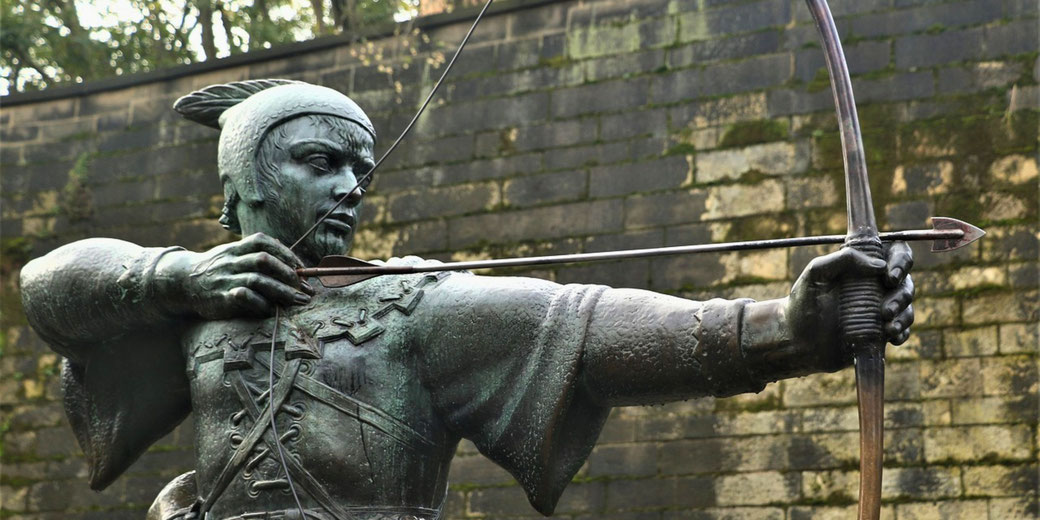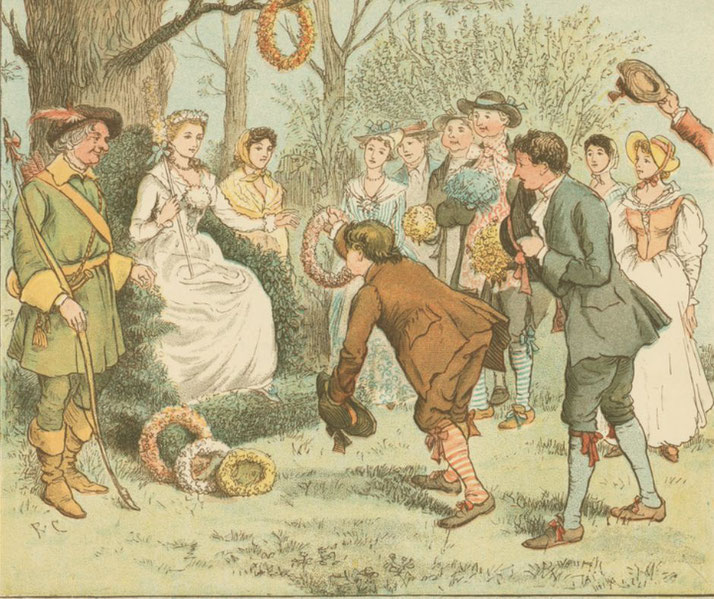Was there ever a real Robin Hood?

Legends often reflect the desires and conflicts of the society that keeps them alive. The figure of Robin Hood, who was celebrated for robbing the wealthy to aid the poor, shows a society's wish for balance and fairness.
Looking into whether such a person ever lived, shows as much about the times that created him as about the man himself.
Who is Robin Hood?
Robin Hood is one of the most long-lasting figures in English folklore and is usually portrayed as an outlaw who lived in Sherwood Forest, near Nottingham, and later stories often place him during the reign of King Richard the Lionheart, who ruled from 1189 to 1199.
During this period, Prince John acted as regent while Richard was away on the Third Crusade.
According to legend, Robin was a skilled archer and swordsman who led a band of outlaws known as the Merry Men.
This group included well-known companions such as Little John, Friar Tuck, Will Scarlet, and the love interest Maid Marian.
Robin’s main opponent was the Sheriff of Nottingham, a figure who represented corrupt authority and feudal injustice.
In most stories, Robin Hood is described as a nobleman who had lost his lands turned to life as an outlaw after authorities wronged him.
This version of the tale became popular in the later Middle Ages and developed further in the early modern period.
His loyalty to King Richard and opposition to Prince John placed him in the wider political conflicts of the Angevin dynasty.
Over time, the story evolved from a local tale into a national story, celebrated in ballads, plays, and eventually films.
However, the question of whether this legendary hero was based on a real person has not been entirely solved.
Key elements of the legend
The core elements of the Robin Hood legend have remained very similar. He steals from the rich and gives to the poor, defends the helpless, and opposes unjust rulers.
His hideout is usually Sherwood Forest, which was part of a royal hunting protected area in medieval Nottinghamshire by the 12th century.
Forest Law, harshly enforced by Norman kings such as William the Conqueror, strictly limited hunting rights and land use, with punishments including mutilation or death for poaching.
In many versions, he is a skilled archer with a longbow and wins contests to prove his skill.
His actions are typically framed as acts of resistance against harsh rule or unlawful authority.
Some versions of the legend place greater emphasis on love story and honour, especially through his relationship with Maid Marian.
Over time, different ballads and stories introduced new characters and adjusted the setting, but the main story of a heroic outlaw that led a loyal band against injustice persisted.
Thanks to these consistent themes, it has meant that the legend was able to change with political and social situations.
Finding evidence for Robin Hood
Despite the wide popularity of the legend, there is no single historical document that confirms the existence of a person named Robin Hood who matched all the features of the tales.
Most of the evidence comes from written sources such as ballads, poems, and later plays.
These were often written long after the supposed time in which Robin Hood lived and were more concerned with storytelling than historical accuracy.
For example, the oldest ballads mentioning Robin Hood date from the late 14th century, more than 150 years after the reign of Richard I.
Historians have searched through legal records and local documents from medieval England in an attempt to find individuals whose lives may have inspired the legend.
Some records mention outlaws with similar names, but the details vary greatly. It is likely that the legend drew upon a mixture of real historical conditions, such as forest laws that restricted common travel and a climate of rebellion that reflected widespread resentment of feudal power, and turned these into a single character.
The outlaw hero became a symbol, rather than a historical account.

The earliest references to the name
The first literary mention of Robin Hood appears in the late 14th-century poem Piers Plowman, written by William Langland around 1377.
In it, one character says he knows "rymes of Robyn Hood," indicating that the name was already known in spoken stories.
Around the same time, other ballads such as Robin Hood and the Monk, circa 1450, and A Gest of Robyn Hode, compiled around 1500, circulated in handwritten copies.
These stories presented him as a yeoman rather than a nobleman, which showed how his image changed over time.
In these ballads, Robin is often portrayed as religious, which led him to attend Mass regularly and give alms, a feature that differs from later romantic portrayals.
By the 15th century, Robin Hood had become a popular figure in May Day festivities.
He featured in various festivities that included performances and pageants in rural communities where locals gathered in celebration.
Maid Marian and a figure known as the Green Man were sometimes included, which suggests possible links to older fertility rituals or pagan customs.
His name also began to appear in legal records, though usually as a common term for an outlaw.
For instance, a record from York refers to a fugitive named "Robert Hood" in the 13th century.
However, none of these references provide clear life details. Repeating the name across different regions and time periods, suggests that "Robin Hood" may have become a stock name for any rebellious or criminal figure.
The real origins of the legend
The earliest stories about Robin Hood focused more on his status as a yeoman than as a nobleman, based upon the social conditions of the 14th and 15th centuries, when the Black Death, economic changes, and conflicts such as the Peasants’ Revolt of 1381 led to widespread discontent.
The yeoman class, who were freeborn commoners who were often skilled archers and farmers, gained greater importance during this period.
Robin Hood may have become a fictional champion of this rising social group.
Many elements of the legend match real social tensions in medieval England.
Sheriffs often acted with considerable independence and were frequently unpopular.
Bandit behaviour was also a serious problem, particularly during periods of weak royal authority.
In this environment, stories of a rebellious yet honourable outlaw gained strong appeal.
During the Tudor period, some ballads about Robin Hood acted as political comment on royal authority and local corruption.
Celtic origins?
Some scholars have suggested that the roots of the Robin Hood story go back further than the Middle Ages and may draw on earlier Celtic or Anglo-Saxon traditions.
Figures such as the Welsh hero Rhiwallon or the Irish outlaw Fionn mac Cumhaill have been named as possible sources.
These were wandering warriors who lived outside the control of kings, fought against brutal treatments, and were associated with forests or the wilderness.
These stories were part of spoken stories long before they were written down, and may have influenced later English folklore.
There are also similarities with earlier tales such as Beowulf and the Arthurian legends.
Like Robin Hood, these stories feature heroes who act according to their own sense of justice, often outside official structures.
Some folklorists argue that Robin Hood may have been a mix of different heroic traditions passed down in northern England and the Scottish Borders.
The theme of the greenwood as a in-between area of justice and resistance appears in both Norse and Celtic mythology.
While no direct link can be shown, the chance of older Celtic effects suggests that the legend may have drawn on a wider pool of cultural narratives.
Real historical people who could be Robin Hood
Over many years, several historical people have been suggested as the foundation for the Robin Hood legend.
One possibility is Robert Hod of York, who appears in the Pipe Rolls of 1225. He was declared an outlaw for unpaid debts and theft, and his property was seized.
Another possible person is Robert of Wetherby, a criminal who operated in the 1260s.
His name appears in the Justiciar Rolls as an outlaw who operated in areas not far from Sherwood Forest.
Other theories have pointed to Fulk FitzWarin, a nobleman who rebelled against King John and lived as an outlaw in the early 13th century.
His story, written down in the Romance of Fulk FitzWarin, shares some similarities with later Robin Hood tales.
Some writers have also named the legend with William of Kensham or Roger Godberd, who was active in Sherwood in the 1260s and 1270s.
Godberd, a former knight, resisted royal forces for several years and was eventually captured and imprisoned, though not in Nottingham Castle as often claimed.
These men all lived outside the law and resisted royal officials, making them possible sources for the legend.
However, no single individual matches all the characteristics associated with Robin Hood, suggesting that he is likely a fictional character built from a mix of real people and myth.
In the Elizabethan period, Anthony Munday's plays from 1598–99 were the first to develop the idea of Robin as the Earl of Huntington over time, which raised him to noble status.
Later, in 1883, Howard Pyle's The Merry Adventures of Robin Hood further shaped the modern image of Robin as a cheerful hero in green tights.
The legend, born from medieval hardship and protest, has continued to change over centuries through new versions.
What do you need help with?
Download ready-to-use digital learning resources
Copyright © History Skills 2014-2025.
Contact via email
With the exception of links to external sites, some historical sources and extracts from specific publications, all content on this website is copyrighted by History Skills. This content may not be copied, republished or redistributed without written permission from the website creator. Please use the Contact page to obtain relevant permission.





